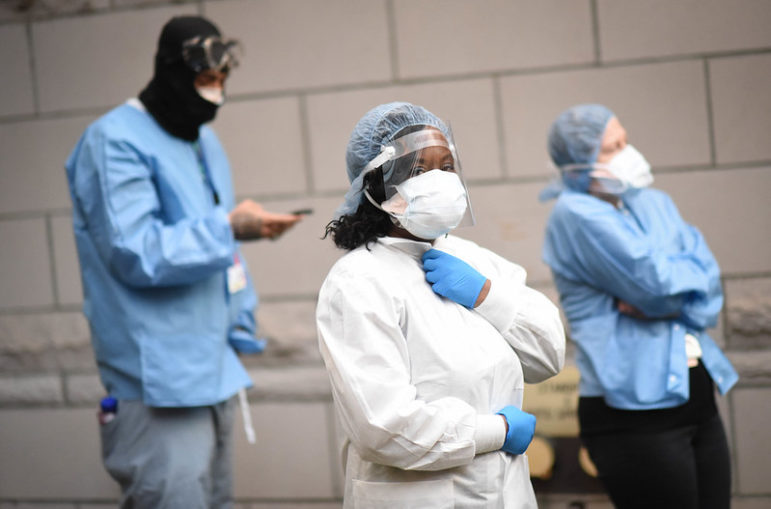
Michael Appleton/Mayoral Photography Office
Staff outside NYC Health + Hospitals/Coney Island. The healthcare industry is exposed to health risks but appears safe from job losses. The hotel sector, however, is being decimated.It’s an era of gargantuan numbers and dismal expectations. Nearly a million New York City schoolkids are learning from home. More than 14,000 people are dead. Millions of masks and thousands of ventilators have been desperately sought.
At least one gargantuan and dismal number could be larger than public officials have been saying.
The city’s Office of Management and Budget has said it expects the city to lose half a million jobs over the first three quarters of this year—from January to September. The Independent Budget Office has projected 475,000 fewer jobs in March 2021 than there were in March 2020.
But two New School economists believe these estimates dramatically understate what has happened just since April 1.
In a report released last week, James Parrott and Lina Moe argue that in this month alone, New York City has lost 1.2 million jobs.
“The current public health and economic crisis far surpasses the personal, psychological, and economic devastation wrought by 9/11, the 2008-09 Great Recession, or Superstorm Sandy,” the two write. “Job losses and new unemployment claims that have mounted since the beginning of the pandemic are unprecedented.”
More than 514,000 city residents filed for unemployment insurance between March 15 and April 11, the numbers rising from 38,000 the week of March 21 to 184,000 the week ending April 11. Figures from the week of April 17 are not in yet. (Before the crisis started, during the week of March 8-14, some 6,600 people applied for unemployment insurance in the city.)
In February, New York City had 3.9 million people employed and 139,000 unemployed. Preliminary data indicates the city’s unemployment rate has already jumped from 3.4 percent in February to 4.2 percent in March. Parrott and Moe, who believe the unemployment filings are a lagging indicator, fear the city’s unemployment rate could hit 27 percent.
The three projections mentioned here—and there are surely others—do not easily permit apples-to-apples comparisons. OMB averages monthly employment figures over a year. IBO projects a point-to-point comparison. Both focus on payroll employment while the New School paper also incorporates freelance and gig work.
In addition, Parrott and Moe derive their estimate by examining specific industries and gauging the likely impact of stay-at-home orders on each. Those impacts vary widely. Healthcare is projected to see a modest immediate 5 percent to 7.5 percent contraction, while hotel payrolls could drop 60 to 75 percent. The aggregate 1.2 million figure, the authors say, is a midpoint of estimates from each of the affected industries.
Under any of the three scenarios, the city is either experiencing or about to endure job losses that dwarf those that occurred during other recent crises. There are other estimates out there, but the state comptroller reported that the city lost 98,600 jobs after the 2007-2008 financial crisis, and 243,000 jobs in the post-September 11 recession. The five boroughs bled some 340,000 jobs after the 1989 downturn. By some estimates, the city shed 600,000 jobs between 1969 and 1976, a period that included a national recession and the city’s fiscal crisis—but played out over seven years.
In other words, numbers like the ones IBO and OMB are projecting haven’t been seen since the city’s deepest crisis. The scale Parrott and Moe foretell hearkens back even further, to the Great Depression, when formal economic statistics were fewer but national unemployment is believed to have hit 25 percent.
It is not surprising that there are wildly different estimates about the employment impact of COVID-19, given the unknowns about the trajectory of the virus, the path that stay-at-home orders will take and the role that the still-unfolding federal stimulus might have. No one knows exactly how far things will drop or how rapidly they might recover. It is possible that the cataclysmic drop Parrott and Moe foretell could be followed by a relatively rapid recovery, so that by next March, the city is “only” down 500,000 jobs.
IBO, which plans to update its employment projections in May as part of the city’s regular budget process, predicts that job growth will resume in March of next year but be slow through the end of 2022. OMB sees growth resuming in 2021 but believes the city’s employment numbers will not return to pre-COVID levels until 2023. Parrot and Moe argue that “it is impossible to say how quickly dislocated workers may return to their jobs once the public health crisis moderates.”
What is clear, however, is that “the current public health crisis has revealed a new dimension of inequality.”
“The three worker categories we analyze occupy distinct places along a new spectrum of inequality: the great personal health risks borne by often underpaid workers in essential jobs; the total economic jeopardy visited upon great numbers of face-to-face workers, with many also more vulnerable to COVID-19 because of their socioeconomic status; and the sharply contrasting circumstance of remote workers (most of whom are professionals and managers) who still have their jobs and benefits, and whose daily existence puts them at much less risk of illness than the other two groups.”
The implications of even-worse-than-expected employment are many.
Akin to the governor’s and mayor’s fear that sick people might overwhelm hospitals before the virus peaked, a sudden surge in joblessness could create human need that swamps the mechanisms that control the public safety net (e.g., thousands of people not even being able to get in touch with the state Department of Labor to apply to unemployment insurance) and private charities, like food pantries.
It also deprives the city of even more tax revenue, potentially necessitating public-sector workforce reductions.
And even short spells of unemployment can imperil a family’s housing, interrupt college plans, deplete wealth and reduce lifetime earnings. The prospect of hundreds of thousands of additional people losing their jobs magnifies that pain across households and years.









